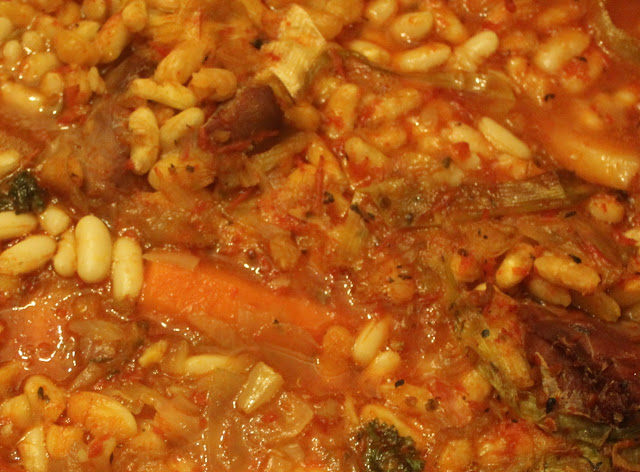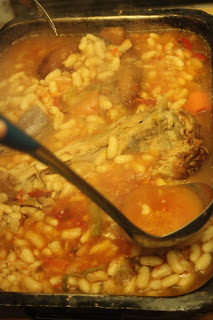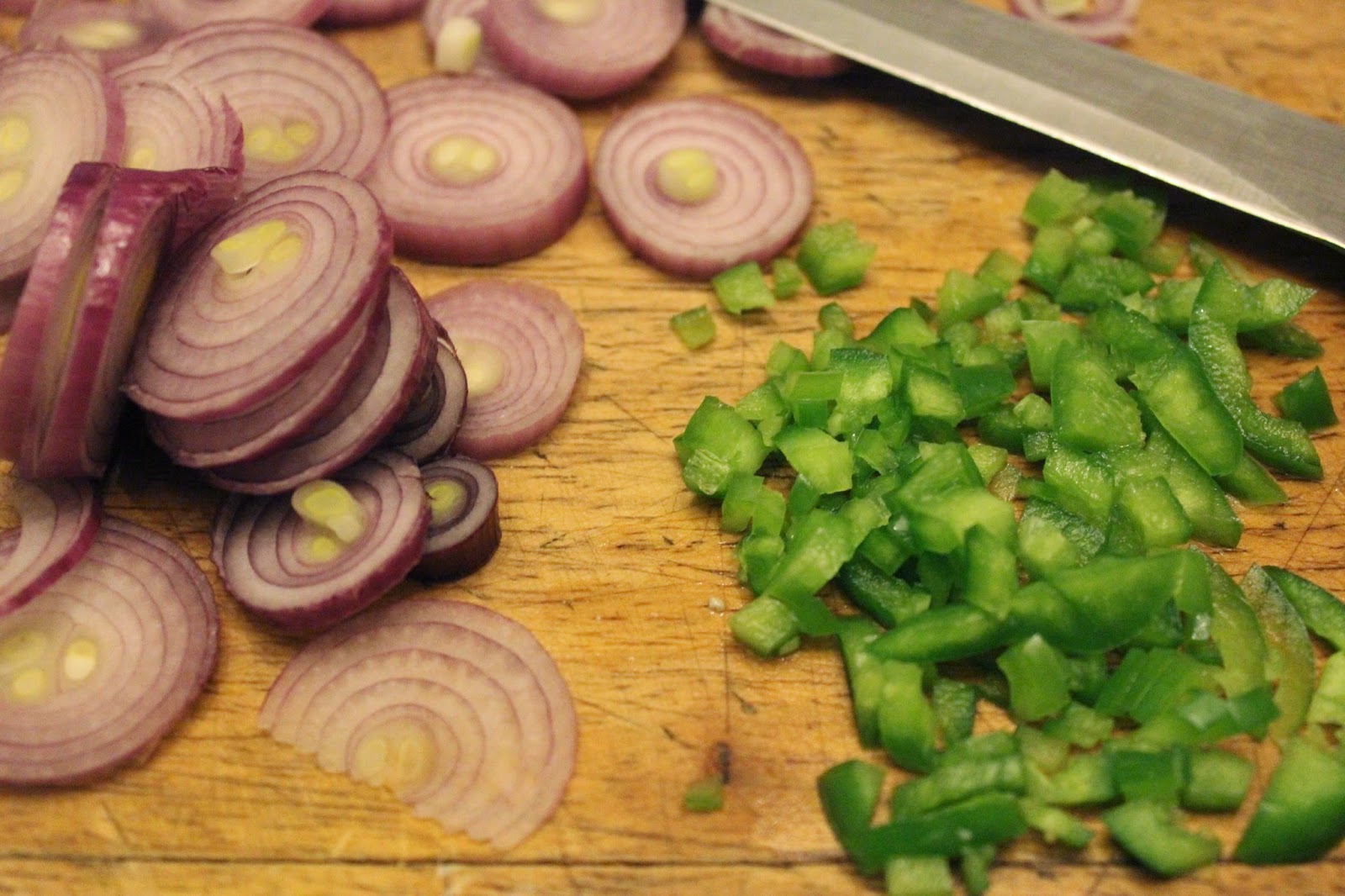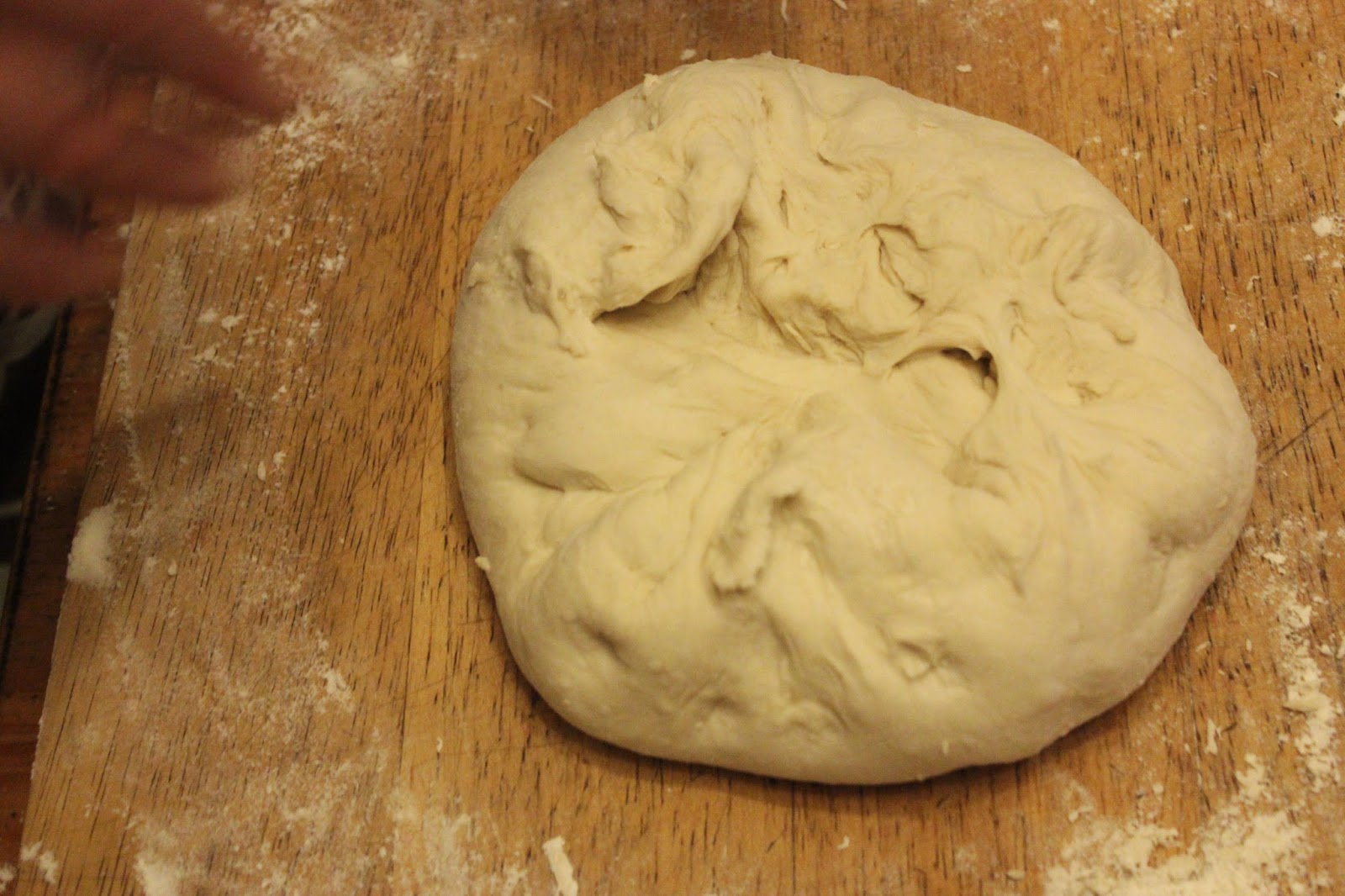Every culture has a dish which, since
time began, has been at its very heart and hearth. Whether cooked in an
old cast iron pot, suspended over an open fire, in an earthenware pot or
in or on a clay oven or even on an upturned shield, it is usually a great peasant dish. It had no written
recipe nor measures but which was added to and amended over time but still with the
same basic ingredients. This is slow food in every sense of the word,
made from good quality, slowly-grown and carefully-raised ingredients and as often
or not cooked continuously. In the case of the following you may be
quite surprised in the recommended cooking time, although I have to
admit to only keeping mine on the go for a week so far!
The poet Anatole France was a great devotee of cassoulet and penned what has become the definitive description of this dish:
'I am going to lead you to a little tavern in the rue Vavin, chez Clémence, who makes only one dish but a stupendous one: le cassoulet de Castelnaudary, which contains the legs of confit d'oie, haricot beans, previously blanched, pork fat and little sausages. To be good it must have cooked very slowly and for a long time. Clémence's cassoulet has been cooking for twenty years. She replenishes the pot sometimes with goose, sometimes with pork fat, sometimes she puts in a sausage or some haricot but it is always the same cassoulet. The basis remains and this ancient and precious substance gives it a savour, which one finds in the paintings of the old Venetian masters...'
Although
often thought of as a Winter staple, we have eaten cassoulet in Gascony, the land of d'Artagnan on a blazing hot Summer's day and it was good. Similarly we have also eaten it on the beach in early March cooked on a home-made fuelless cooker.
I usually make ours with left-overs such as the remainder of a boiled and roasted ham hock and/or the special offer deal I have mentioned before; the end of the Parma ham. My mother, who makes a mean cassoulet, uses duck legs, which she first browns in the frying pan. Both of us also use merguez, which if you are unfamiliar with them, are spicy mutton or beef sausages from North Africa. All the ingredients are organically grown or raised. Everyone has their favourite cassoulet recipe but in the main the ingredients are as follows:
Meat - usually pork, ham, duck either fresh or preserved, preserved goose, sausages, merguez, chorizo - alone or in combinations
White 'haricot' beans around a ¼ kilo or ½ lb
A good rich home-made stock! This is one of the most important parts of the cassoulet, as without it you will not get the depth of flavour. I usually make boiled and roast ham hock and then keep part of the ham and all of the remaining stock to make a cassoulet. This way I get the optimum nutrient and flavour from the meat and vegetables in the original stew.
4 Tomatoes or 2 tablespoons of tomato purée
Onions and garlic
4 large carrots
Herbes de Province I use a tisane mix for this which is made up of, thyme, savory, marjoram, rosemary, hyssop and oregano
I usually make ours with left-overs such as the remainder of a boiled and roasted ham hock and/or the special offer deal I have mentioned before; the end of the Parma ham. My mother, who makes a mean cassoulet, uses duck legs, which she first browns in the frying pan. Both of us also use merguez, which if you are unfamiliar with them, are spicy mutton or beef sausages from North Africa. All the ingredients are organically grown or raised. Everyone has their favourite cassoulet recipe but in the main the ingredients are as follows:
INGREDIENTS for a large cassoulet (see volumes below)
Meat - usually pork, ham, duck either fresh or preserved, preserved goose, sausages, merguez, chorizo - alone or in combinations
White 'haricot' beans around a ¼ kilo or ½ lb
A good rich home-made stock! This is one of the most important parts of the cassoulet, as without it you will not get the depth of flavour. I usually make boiled and roast ham hock and then keep part of the ham and all of the remaining stock to make a cassoulet. This way I get the optimum nutrient and flavour from the meat and vegetables in the original stew.
4 Tomatoes or 2 tablespoons of tomato purée
Onions and garlic
4 large carrots
Herbes de Province I use a tisane mix for this which is made up of, thyme, savory, marjoram, rosemary, hyssop and oregano
A stick of celery
A glass of red wine
Breadcrumbs
VOLUMES
The dish I use is a stainless steel stew pan 37cm x 26cm x 5.5cm or 14½" x 10½" x 2¼", this will take most of the stock in my ham hock pot, which once the meat and vegetables have been removed, is around 5 litres or 10½ pints. You need a goodly amount of stock as you will need to add extra as the cooking progresses and if in particular you want to keep this dish going for several meals.
TEMPERATURES & TIMES
The cassoulet should cook at around 150ºC to 160ºC or 300ºF to 325ºF for at least 3 hours.
Not All Beans Are The Same
Although many recipes written in English mention 'haricot' beans, in French this word just means bean. What became known as the Tarbais bean variety which is the one used in the authentic cassoulet, was originally grown by the Aztecs and was one of the first products imported into Europe from South America. In the 16th century and to show how important a resource they were considered; Catherine de' Medici actually brought bean seeds with her as part of her dowry, when she married the French king, Henri II.
Bean seed came through Spain and to the Pyrénées, where they were planted in a time of great famine in the plains of Tarbes, where they were seen as a miracle food. The bean we often use for cassoulet is actually this ancient and quite easy to grow variety. For the purists, Tarbais is the only bean for cassoulet, possibly because it is large and buttery and absorbs the rich sauce of the cassoulet so deliciously.
Quick Soak aka Power Soak Method for Beans
There are all sorts of arguments about soaking beans but we use the following method. Wash the beans and then put them into a large pan of cold water. The water should be 5cm to 7.5cm or 2" to 3" above the beans. Bring to the boil quickly on a high heat. Boil for a minute and then remove from the heat. Leave to soak for one hour, then drain them and rinse them. They are now ready to be cooked. The beans are then cooked by placing them in a good volume of cold water, with 5cm or 2" above the level of the beans. Bring to the boil and simmer for 10 to 15 minutes until they are tender but not breaking up. This way when you add them to your cassoulet they will be hot and ready to absorb the flavours.
Making the Stock
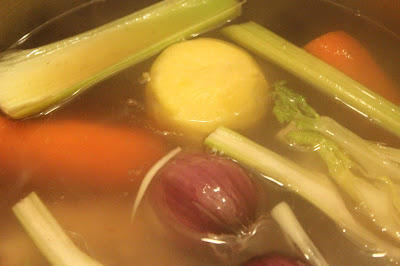 |
| Pigs' Trotter Stock - Before the Roast |
As I mentioned above the most important ingredient in this dish is really the stock. For the flavour to carry throughout, the stock will also need a certain level of fat. This is one of the reasons for using preserved goose (or duck), as this is traditionally kept in earthenware jars under a layer of goose fat. The rich creamy yellow fat is packed with beta-carotene from the goose's 100% pasture-foraged diet. A good stock is what makes the dish so capable of being extended and added to without detriment to the flavour, as suggested in the words of Anatole France above.
 |
| Ham Hock Stock - After the Roast |
If you are not using the stock from a recent meal such as with my ham hocks, then I suggest you take every opportunity to build up a reserve of bone broths and stews from every meat meal you eat. This is not only of importance to taste but also to the integrity of your skeleton and teeth and particularly a good insurance against all the conditions that are de facto attributed to old age. It is also a way of ensuring that your organic meat budget will go a lot lot further. That is another reason I enjoy dishes like this, they stand for a time when food was valued, unlike our present wasteful society. Throwing away food runs counter to all that organic stands for, if an animal is to be eaten we should eat it all and with organic you are safe so doing, as there are no toxic residues in the fat and offal. You can make bone broth from the cheapest cuts of meat even if you don't fancy actually eating them, pigs' trotters spring to mind, although we actually do eat them. The stock from the initial boiling of them makes a superb gelantinous base from which to build up a dish such as cassoulet.
METHOD
Starting with the stock add the chopped tomatoes or paste and heat to just around boiling.
If you are using uncooked sausage or merguez, brown them first in the pan with the garlic and onions
Then add them to the other meat(s) in your stewing pan or earthenware dish along with the cooked beans. As you see below each time I make this dish I use different ingredients and sometimes even different beans - these right are an old variety know as 'coco', which is all I had to hand at the time.
Now add your stock, vegetables and herbs.
Pour on a glass of red wine. I always use a good robust one such as a Merlot or Syrah, it is a mistake to use rich flavoured quality ingredients and then add a jejune wine, better to leave it out all together. If you intend drinking wine with this dish and it needs a full-bodied red, from an area with plenty of sun, then use that. The cassoulet is now ready for the oven.
After the cassoulet has begun to thicken (around a half hour into cooking) I add a layer of breadcrumbs and then as cooking continues I break the crust, mixing it in and adding more stock. I then add a further layer of bread crumbs. The breadcrumbs create a crust and keep the dish moist but if you are gluten free then you just need to keep your eye on the dish adding more stock and more frequently.
If you've enjoyed this post then please feel free to share it, ask questions, comment and/or join this blog.
Hope to see you here again for another recipe from an old farmhouse in Normandie,
Sue
Thanks to the Pinterest boards of DrGio Nguyen and amicidegliuffizi.it for the images of Anatole France and the detail from the painting by Jacopo da Empoli, Matrimonio di Caterina de' Medici con Enrico II di Francia 1600, respectively.
Return to 'WHAT'S ON THE MENU' for more Simply Organic Recipes
© 2016 Sue Cross
 |
| The joy of using what you have! |
Now add your stock, vegetables and herbs.
Pour on a glass of red wine. I always use a good robust one such as a Merlot or Syrah, it is a mistake to use rich flavoured quality ingredients and then add a jejune wine, better to leave it out all together. If you intend drinking wine with this dish and it needs a full-bodied red, from an area with plenty of sun, then use that. The cassoulet is now ready for the oven.
After the cassoulet has begun to thicken (around a half hour into cooking) I add a layer of breadcrumbs and then as cooking continues I break the crust, mixing it in and adding more stock. I then add a further layer of bread crumbs. The breadcrumbs create a crust and keep the dish moist but if you are gluten free then you just need to keep your eye on the dish adding more stock and more frequently.
This is a dish that stands alone but I like to follow it with a green salad.
Hope you enjoy it and now, if you'd like to, sit back and see how we used this recipe to test out our home-made fuelless cooker on a very cold Winter's day on the beach.
If you've enjoyed this post then please feel free to share it, ask questions, comment and/or join this blog.
Hope to see you here again for another recipe from an old farmhouse in Normandie,
Sue
Thanks to the Pinterest boards of DrGio Nguyen and amicidegliuffizi.it for the images of Anatole France and the detail from the painting by Jacopo da Empoli, Matrimonio di Caterina de' Medici con Enrico II di Francia 1600, respectively.
Return to 'WHAT'S ON THE MENU' for more Simply Organic Recipes
© 2016 Sue Cross

